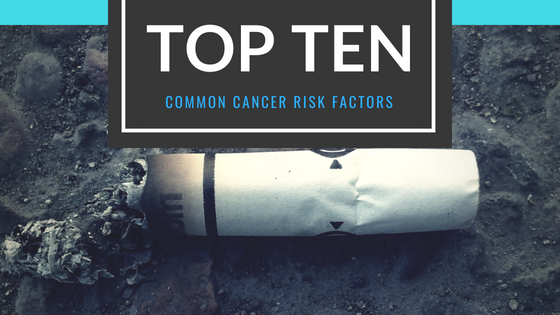
November 4, 2018
Cancer and Diarrhea

According to the World Health Organization, one third of all cancers can be prevented. In order to prevent cancer from happening, we need to look at what are our risk factors.
There are two type of prevention: Primary prevention and Secondary prevention. Primary cancer prevention means that you are preventing cancer from happening without a prior cancer diagnosis. Secondary cancer prevention means that you are preventing cancer from developing after a prior diagnosis. In my clinic, we look at both.
What are some of the common risk factors?
1. Smoking: it is not just associated with lung cancer, it also increases oxidative stress and increase chances of DNA damage in cells and that increases your chance of getting any types of cancer, not just lung cancer. It is estimated that smoking is responsible for 30% of all cancer deaths. Breathing or living in smoky environment also increases your chance of getting cancer (second hand smoke).
2. Poor body weight: We are working our organs so much harder as we gain more weight. New blood vessels need to be formed; new skin cells replicated to cover the area, more blood and nutrients needed to be provided to the new territories. Those changes, when it gets too much, can overburden our system and increase the oxidative stress.
3. Processed meat: A few years ago, World Health Organization came out with the statement that processed meat is bad for your health. One of the most solid evidence provided was the fact that processed meat may increase the risk of esophageal cancer, prostate cancer, and also colorectal cancer.
4. Sedentary Lifestyle: Believe it or not, sedentary lifestyle is linked to colorectal cancer incidences. It also strongly links to uterine, breast and lung cancer.
5. Alcohol: how much alcohol is too much when it comes to cancer prevention? Answer? One sip is still too much. The less you drink, the more you can reduce the risk of cancer.
6. Deathly Sun Rays: Yes, we need our vitamin D from the sun, but it is the UV that we are trying to get away from. UV increases your chance of damaging your DNA. Yes, that also includes tanning equipment.
7. Environmental exposure of chemicals and heavy metals: Radon is a colourless, odourless gas that can be found in some houses. Radon is found in air, and when it breaks down, that is when it is harmful to the body. Radon increases our chances of getting lung cancer. Pesticides and common shampoo/body wash chemicals have also been linked to specific cancers.
8. Hormone Replacement Therapy: Some people may need it, but research has been very thorough with the potential harm of hormone replacement therapy: it may possibly increase risk of breast cancer, uterine and ovarian cancer.
9. Oral Contraceptive Pills: Long term exposure to oral contraceptive pills can increase risk for breast, cervical and hepatocarcinoma (cancer in the liver). However, it can act as a protective measure against ovarian or cervical cancer.
10. Low immune system: a successful tumor growth mostly occurs when your various immune mechanisms has failed. At that point, your body has failed to correctly identify cancer cells and eliminate them. It allows your cancer cell to continuously grow unchecked.
Comments are closed.
29 thoughts to “Top 10 Common Cancer Risk Factors”
Pingback:pudbiascan.strikingly.com
Pingback:india tadalafil tablets
Pingback:viagra walmart
Pingback:20mg cialis online
Pingback:vietnamese viagra
Pingback:best generic cialis
Pingback:cialis singapore buy
Pingback:10mg cialis price
Pingback:5mg cialis dosage
Pingback:tadalafil cialis bestprice
Pingback:cialis tablets
Pingback:tadalafil at costco
Pingback:cialis c20 pill
Pingback:best pricecialis
Pingback:of 5mg cialis
Pingback:cialis 5mg cost
Pingback:cialis mail order
Pingback:tadalafil 5mg india
Pingback:sildenafil
Pingback:20mg sildenafil
Pingback:https://hafbeltminla.zombeek.cz/
Pingback:viagra generics price
Pingback:pharmaciesshipping.wordpress.com20230515canadian-pharmaceuticals-online-with-no-prescription
Pingback:https://www.horreur.club/community/profile/canadianpharmacy/
Pingback:https://essidi.cm/community/profile/canadianpharmacy/
Pingback:www.careerstek.comforumprofilecanadianpharmacy
Pingback:backlink from wikihow
Pingback:canadian rx
Pingback:canadian pharmacy uk delivery